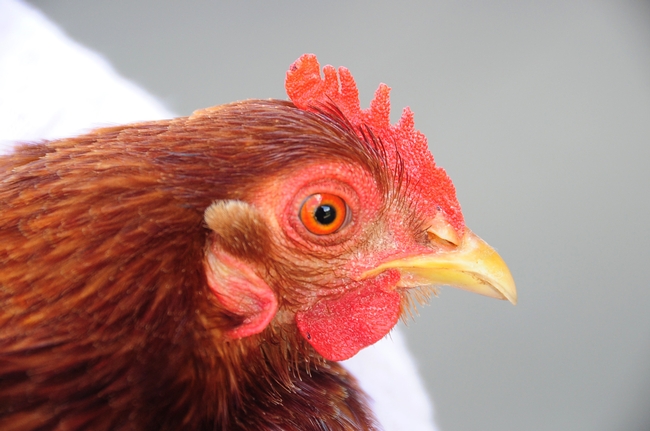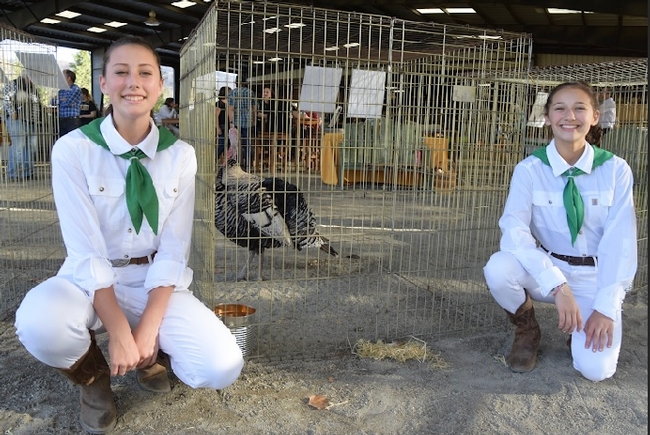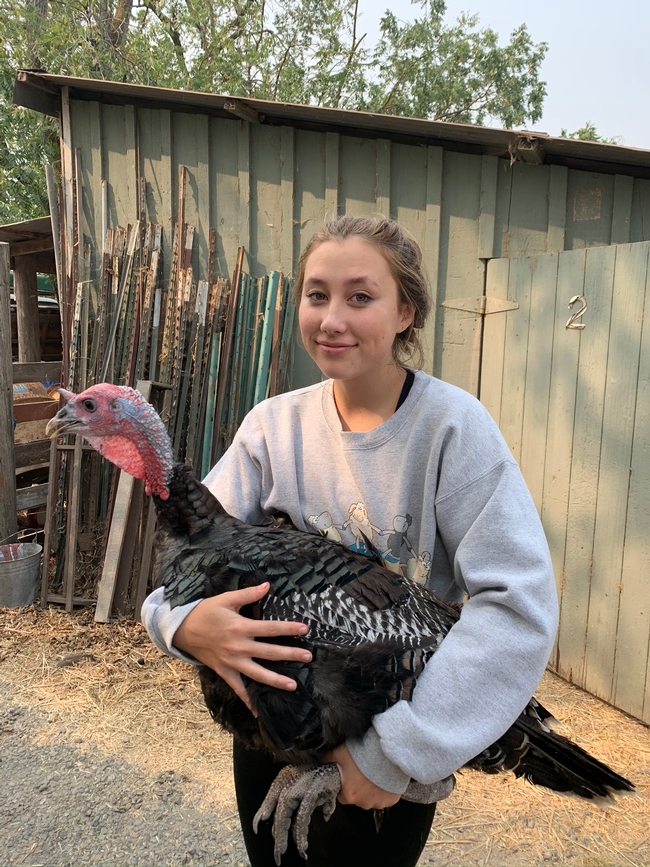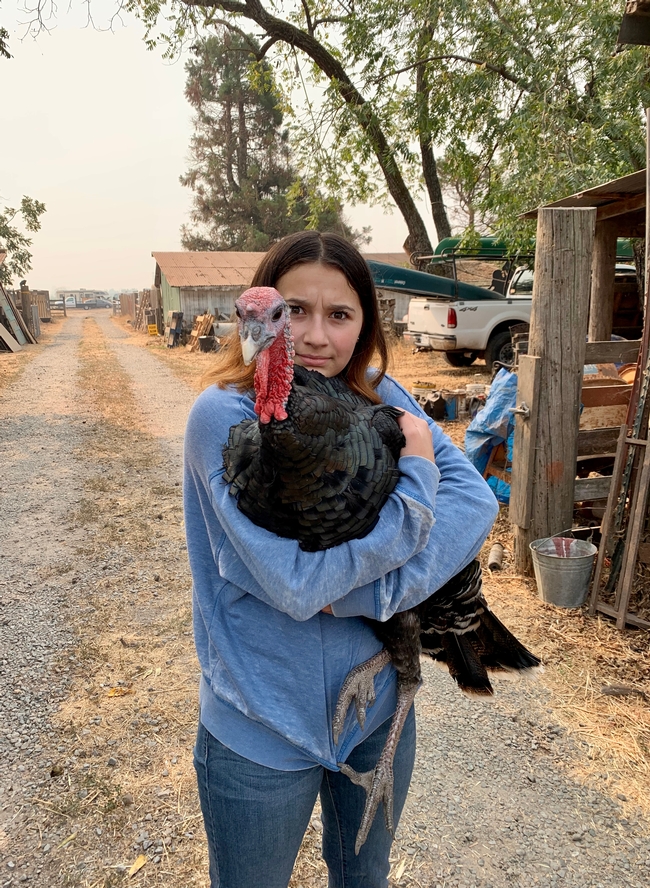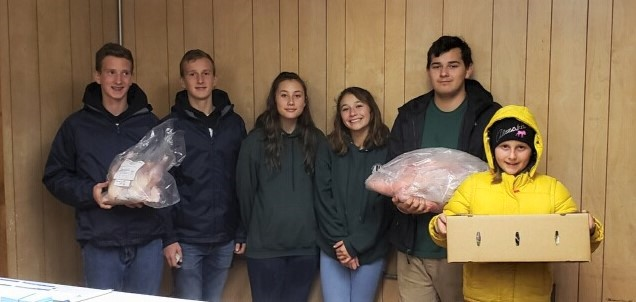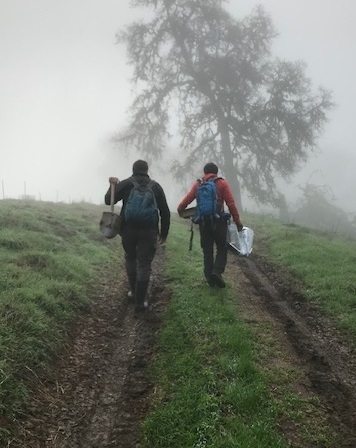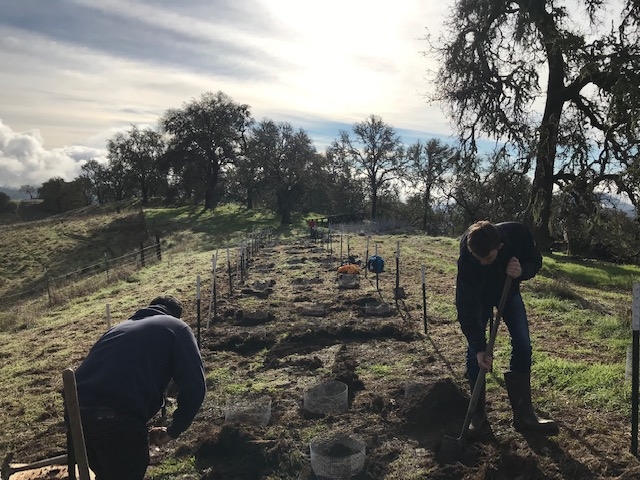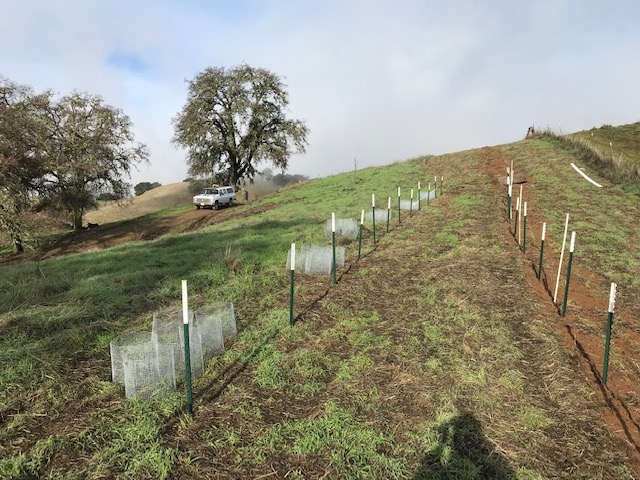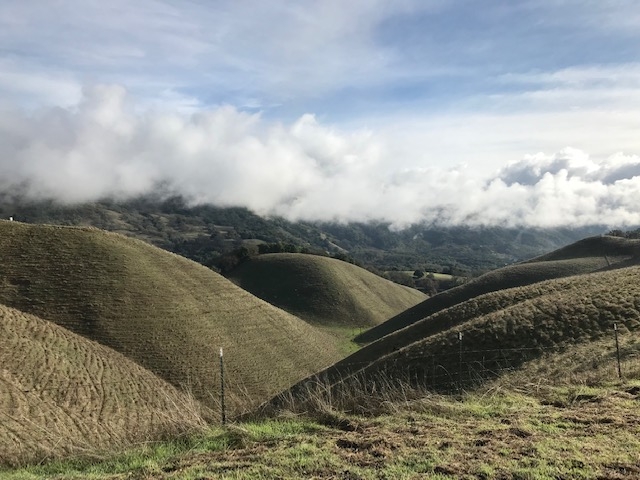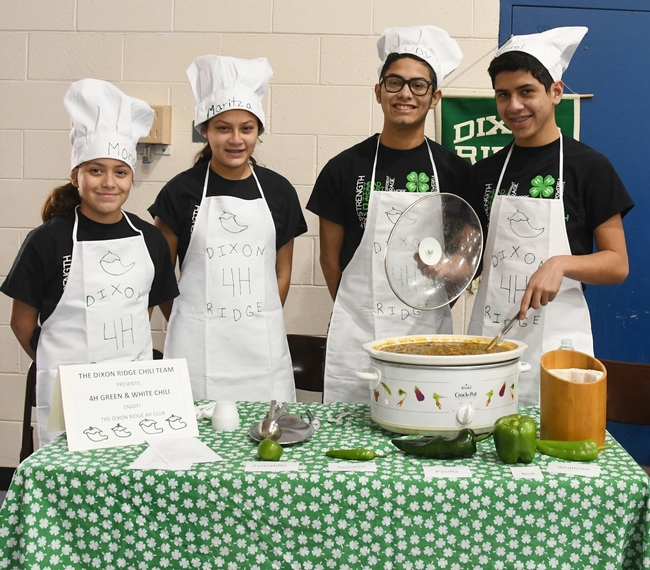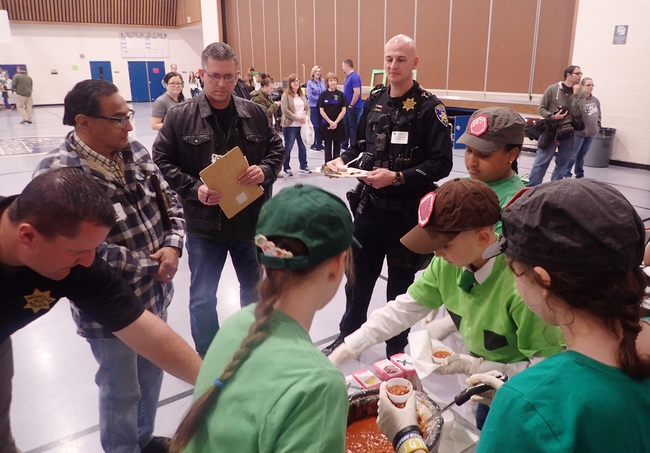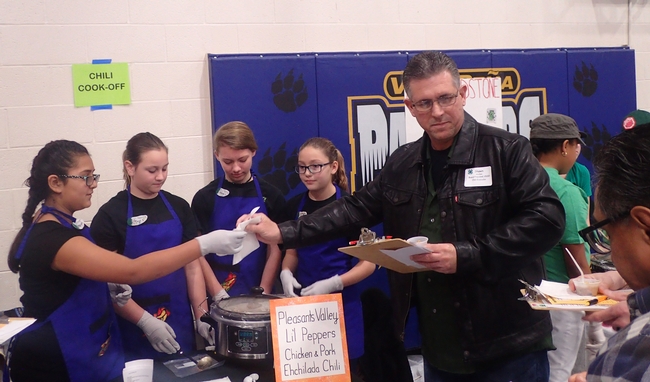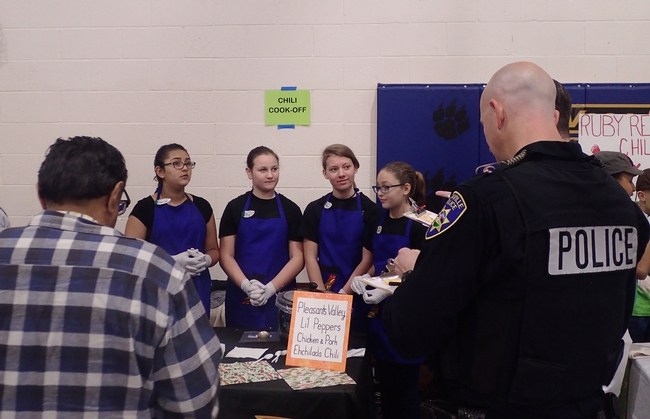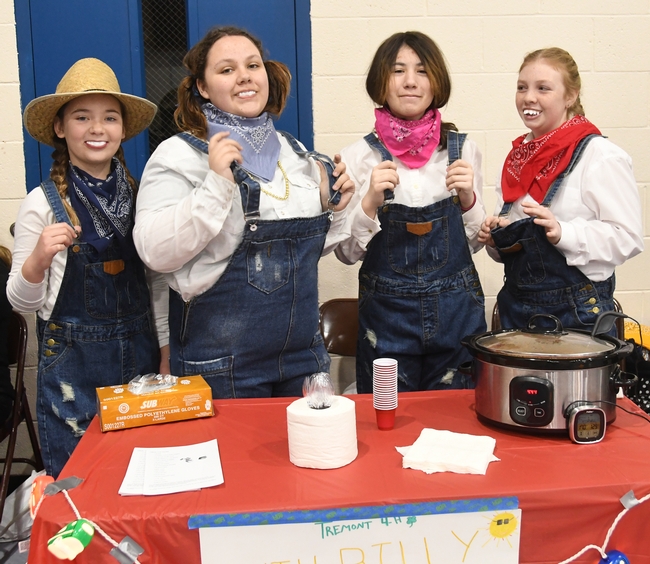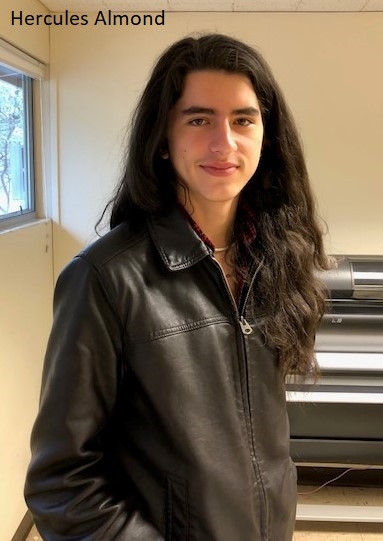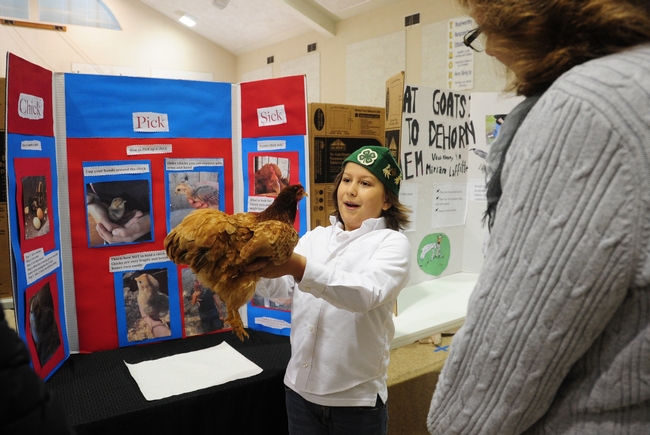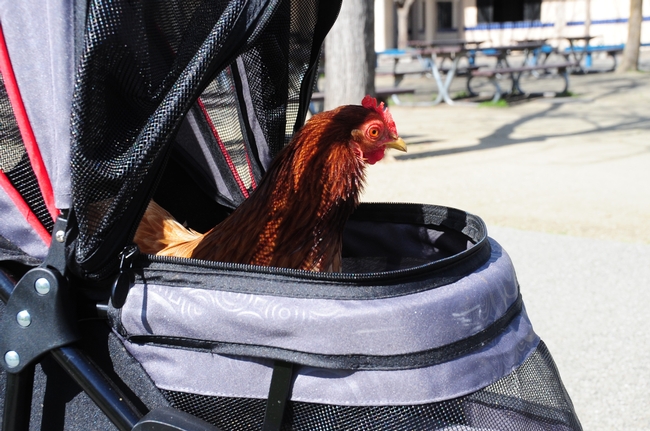
Posts Tagged: Youth Development
4-H youths raise turkeys to save for college and learn about farming
While most Americans choose their Thanksgiving turkeys from the meat department at the local grocery store, Brylee Aubin and Yaxeli Saiz-Tapia can tell you the life histories of their holiday birds. The Sonoma County teenagers raise heritage turkeys together as part of a 4-H youth development project and sell them for Thanksgiving. For the last two years, Yaxeli's older brother Uli has joined the project and, between the three of them, they raised 47 turkeys this year.
The Heritage Turkey Project in Sonoma County has about 15 members of the UC Cooperative Extension's 4-H youth development program and the National FFA Organization growing more than 200 heritage turkeys this year, according to Catherine Thode, who has been leading the project for 15 years.
“Our project leaders are active breeders of heritage turkeys and some of our 4-H and FFA youth are now raising breeding pairs and hatching their own birds,” Thode said. “Each project member raises their small flock of birds on their own property and shoulders the responsibility of providing their feed and care.”
The Heritage Turkey Project promotes the preservation of heritage turkey breeds, sustainable farming and responsible animal husbandry. While raising the animals, the youths learn life skills and earn money for their work.
“The money I raise from raising and selling turkeys goes towards my college fund and to more 4-H projects like market goats or sheep,” said 15-year-old Brylee, who sells her turkeys for $9.50 per pound.
Three years ago, Brylee's neighbor, Yaxeli joined her in the heritage turkey project.
“I have learned how to care for animals, the importance of raising organic and the costs involved,” said Yaxeli, 14. “I have gained a firm understanding of how my birds are raised and processed versus corporate methods. Having the opportunity to participate in this project has strengthened my value for the importance of where my food comes from.”
Consumers benefit by getting turkeys that are farmed organically, fed high-quality grains, and never frozen, said Brylee.
“There are so many benefits to raising these beautiful birds,” said Uli Saiz-Tapia, 17. “First, you learn the cost of running a business, how to reinvest for the next year, the different stages of turkey growth and how to manage issues that arise such as the turkeys fighting, how they react to fluctuating temperatures, how to keep them safe and nourished properly. Learning about the process of getting our turkeys ready to be purchased has really benefitted my understanding of anatomy, the amount of work it takes in preparing them and the importance of not wasting food.”
The group sold out of turkeys in early November.
“Back in March, we really wondered if we should even do the project this year, not knowing what was going to happen with COVID restrictions and the impact on the economy,” Thode said. “We ended up with more project members than we've ever had, and over 200 turkeys to be sold for the Thanksgiving market.”
The 4-H members started the season with more turkeys, but lost some birds to predators. Wildfires seemed to drive more predators to the Sonoma County farms this year, she said.
“Things are fast and furious right now,” Thode said a week before Thanksgiving as the group prepared their turkeys for processing and distribution to people who placed orders. “I'm about to enter the busiest seven days of our year. It will take all weekend to have the birds processed, weighed, labeled. Then, we hunker down to sort and assign turkeys to our customer list.”
While selling turkeys, the group encourages customers to meet the farmers and to visit https://livestockconservancy.org/index.php/heritage/internal/conservation-priority-list#Turkeys to look up the history and breed characteristics of the turkey they are purchasing. In past years, some customers have taken photos of themselves with the person who raised their bird.
“We not only have a master list of customers and their desired sizes, but we create a spreadsheet for every project member with a list of the turkeys they've grown that year,” Thode said. “Each turkey is identified in the spring or early summer with a small metal wing band that lists the grower and an individual number for that turkey. When the turkey is sold, the buyer knows which project number grew their turkey, and the variety of turkey that they are purchasing. We think it's important that our customers know this. In fact, when they come to pick up their turkey, they write their check to the actual grower of their turkey.”
To learn more about the Heritage Turkey Project, visit https://heritageturkeyproject.webs.com.
HREC Youth Volunteers Support Oak Research
My name is Valentina Evans, and I am a new volunteer at the UC Hopland Research and Extension Center. My partners Benjamin Evans, and Zane Petersen have chosen to volunteer with me at the HREC for our senior project at Ukiah High School. A few weeks ago on the twenty-first of December we volunteered to help two researchers, Paulo who studied at UC Santa Cruz, and Wyath, who is still studying at Humboldt State University, to plant acorns from different ecosystems, and analyze how they will adapt to conditions with more water, less water, more sunlight or a lack of sunlight. This study is part of Dr. Blair McLaughin's study from the Zavaleta Lab at UC Santa Cruz.
We started off by digging holes about 1 foot deep and laying a thin square piece of chicken wire at the bottom of the holes to prevent gophers from entering and eating the acorns. We then took a circular strip of chicken wire and placed it on top of the flattened piece at the bottom. With the second strip of chicken wire standing horizontal, we continued by covering the holes with the same dirt we originally dug out. Now with the metal secured in place, Paulo came around and gently placed the acorns inside of the holes. The hands-on experience was extremely fascinating, not to mention peaceful. The view at the top of the hill was breathtaking, and the weather was just perfect. The entire process was tiring, but having had the opportunity to participate in a lab/research project made the whole experience worth it.
Although the project will not produce any data until the acorns sprout, the idea behind the project is captivating. Paulo and Wyath are studying the growth of oak trees from all sorts of climates, locations, and ecosystems. Some of the acorns are from northern California and others from way down in southern California. They will be monitoring the water levels, and amount of sunlight the oak trees will receive, all in hopes to see how the oak trees will adapt to different changes in their environments. Seeing as how I want to major in Biological Sciences in college, this experience was exceptionally informative for me and has taught me how critical patience, effort and time are in order to successfully accomplish a lab and receive the most accurate facts. I am very grateful to have been able to participate in this ongoing project and am looking forward to continuing to be a part of the younger generation who can benefit from having the Hopland Research and Extension Center available to us, to further our knowledge about the environment.
4-H chili cookoff: Heralding green and white
What's green and white and wins a county 4-H chili cookoff?
Chili, 4-H chili.
And it's just in time for Super Bowl Sunday on Feb. 4 when the New England Patriots square off in Minneapolis, Minn., with the Philadelphia Eagles.
A sibling team from the Dixon Ridge 4-H Club won the 2018 Solano County 4-H Chili Cookoff with a recipe titled “4-H Green and White Chili," featuring pork shoulder and pork sausage and four different varieties of peppers. The five-team competition took place at the Pena Adobe Middle School, Vacaville, during the Solano County 4-H Project Skills Day.
The members of the Dixon championship chili team - Maritzia Partida Cisneros, Miguel Partida Cisneros, Moncerrat “Monce” Torres Cisneros and Rudolfo “Rudy” Radillo Cisneros - used four different green peppers: pasilla, Anaheim, serrano and green bell pepper to flavor and spice the white (pork) chili.
The siblings competed last year as the “Mean Green Machines,” wearing their official green and white 4-H uniforms and hats. This year they chose the same recipe but adjusted its heat. They also donned different 4-H attire along with white chef hats, inscribed with their names.
The Dixon Ridge team competed against Team Delta of the Rio Vista 4-H Club, which prepared “Chili-licious”; Hillbilly Chili Team from Tremont 4-H Club, Dixon, “Hillbilly Chili”; Lil' Peppers Team from the Pleasants Valley 4-H Club, “Chicken Enchilada Chili” (the team won last year's competition); and Team Minecraft of the Sherwood Forest 4-H Club, Vallejo, which prepared “Ruby Redstone Chili.”
They answered questions from the evaluators and served them samples. John Vasquez Jr. of Vacaville, member of the Solano County Board of Supervisors, judged the chili contest with Vacaville police officers Jeremy Johnson, Shawn Windham and Steve Moore. Windham is also the president of the Vacaville Unified School District Board of Trustees.
The evaluators all described the chili dishes as delicious, said coordinator Kelli Mummert, a community leader in the Pleasants Valley 4-H Club, Vacaville.
"The Chili Cook Off is a great hands-on opportunity for youth to build confidence and spark their creativity," said Valerie Williams, Solano County 4-H Program representative. " Chili team members build food preparation skills, learn food and kitchen safety, and use math and science concepts, as they develop their chili recipes."
Each member of the winning team received a $15 Cold Stone Creamery gift certificate.
“I would have to say that I was extremely impressed with all of the teams and their entries in the contest,” said Windham. “While there was one clear winner of the contest, every one of the teams made a very good chili and showed that they have a strong ability to work together as a team collaboratively and that they have very strong cooking skills.”
“I think all of the teams showed maturity and had a great presentation for their chili,” Windham said. “They were each very enthusiastic about their creation. I found all of the chilis to be very good and I thought the teams did an excellent job of representing 4-H. I was also very pleased we were able to host the event at one of our Vacaville Unified School District schools.”
Windham added: “I will be honest in that I wasn't sure what to expect because I haven't been involved with the chili contest before. However, I was very pleasantly surprised and really enjoyed each of the teams' creations and the ability to talk with the kids about how they came up with the recipes for their chili. It is a lot of fun and I hope to get an invite again next year!”
Said Vasquez: "I believe this year's winning chili had all the qualities that a winning chili should have: flavor, aroma, texture, color and presentation. I enjoyed having three police officers from the Vacaville PD this year as judges. Their skills in remembering in great detail made the job of judging much easier, as we refer back to our notes on each one of the entries. I've had the honor of attending as a judge and as a presenter of awards on both Project Skills Day and the 4-H Achievement Night for 16 years. Over the years, Shelli (his wife) and I have watched young 4-H'ers grow to become young, impressive adults and that has been rewarding to us.”
Moore said all the team members were "polite, professional and knowledgeable for their age group. While the consensus was one winner, I feel that each team presented a good product. For me, it was my first time attending a 4-H-sponsored event and I was very impressed." He is interested in involving his two sons in 4-H.
The other participants of the cookoff:
- Hillbilly Chili Team, Tremont 4-H Club: Alaina Austin, Isabel Martinez, Trinity Road and Sara Yates
- Lil' Peppers Team, Pleasants Valley: Jessie Means, Maya Farris, Naomi Lipary and Maliyah Desmarais
- Team Minecraft Team, Sherwood Forest: Darren Stephens, Celeste Harrison, Julietta Wnholds and Hanna Stephens
- Team Delta, Rio Vista: Olivia Stone, Anuheua Rivas, Maddie Baughman and Sofia Gutierrez
Here's the winning recipe, heralding the green and the white:
4-H Green and White Chili
Dixon Ridge 4-H Club
2 pounds pork shoulder cut in ½-inch chunks
2 pounds ground pork sausage
Olive oil (as needed to brown meat)
Two 28-ounce cans green enchilada sauce
2 onions, coarsely chopped
2 of each pepper diced: pasilla, Anaheim, serrano and green bell pepper
2 cloves of garlic, minced
2 tomatillos, diced
1 bunch of cilantro, chopped
Water, approximately 1 cup
Cornstarch for thickening if needed
Seasonings to taste: chicken bouillon, black pepper, garlic salt and cumin
Directions: In a large stock pot, brown pork in the olive oil. Add the ground sausage and continue cooking over high heat until meat is browned (about 30 minutes). Add the water and seasonings. Cook an additional 30 minutes. Add green enchilada sauce. Turn heat down and simmer for 30 minutes. While mixture is simmering, coarsely chop the onions, mince the garlic, dice the peppers and tomatillos and chop the cilantro. Add these to the pot and continue cooking until the pork is tender (about 30 to 45 minutes). Check flavor and adjust seasonings to taste. If needed, thicken with the cornstarch.
The Dixon Ridge, Tremont, Pleasants Valley, Rio Vista and Sherwood Forest 4-H Clubs are among the 12 clubs in Solano County. The others are Maine Prairie 4-H, Roving Clovers 4-H, both of Dixon; Elmira 4-H, Vaca Valley 4-H, both of the Vacaville area; Westwind 4-H and Suisun Valley 4-H, both of Fairfield-Suisun; and Travis Air Force Base 4-H Club from Travis.
The Solano County 4-H Youth Development Program is part of the UC Cooperative Extension Program. The four H's stands for head, heart, health and hands, with the motto “Make the Best Better.” 4-H is open to all youths ages 5 to 19. In age-appropriate projects, they learn skills through hands-on learning in projects ranging from arts and crafts, computers and leadership to dog care, poultry, rabbits and woodworking. They develop skills they would otherwise not attain at home or in public or private schools. For more information, contact Solano County 4-H Program representative Valerie Williams at vawilliams@ucanr.edu or link to http://solano4h.ucanr.edu/Get_Involved/.
Youth volunteering allows potential for growth at HREC
During 2017 over 3800 hours of volunteer time were offered at HREC! Our incredible volunteer team helps across all areas from citizen science on our phenology project to working with children and adults at our educational events. The California Conservation Corps also volunteer their time and enjoy learning new skills such as chainsaw safety and technique with us.
We are thrilled to welcome a number of new youth volunteers to this program at the beginning of 2018, including 16 year old Hercules Almond who comes to us with a sharp mind and wonderful way of expressing himself and the world around him, enjoy this, the first blog post from Hercules as he expresses his first experiences on our site:
"Driving up through the light mid-morning mist that envelopes the hilltops on the way to the Hopland Research and Extension Center (HREC) is ever a joyous and smile-inducing trip to undertake from my home in Hopland. While I've only begun to truly frequent it, it has always been a place that I have enjoyed venturing to immensely, with its landscape rolling at points, being steep in others, sheep spotting the various fields and pastures as the sun may begin to shine through the cloud cover and bathe it all in a warm glow.
I find myself slightly taken aback by the sheer scope of activities and goings-on that occur here… between the vast diversity of flora, the myriad of fauna that can call it home, the enormous plethora of sheep, and how the local ecosystem works in concert with the factors that contribute to its development and evolution, the entire acreage holds so much potential for all manners of research, study, and boundless expansion upon our understanding of the natural world out here and all around us.
To be completely honest, I've been ecstatic about almost everything to do with nature and the wilderness since I was a small child, fascinated by the most miniscule of insects and most gargantuan of trees at the very same time, loving nothing better than to live out away from all the noise and congestion of both cities and towns in general. I'm at peace with little but the sounds of the wind and birds surrounding me as I stand in a damp forest or on the top of a high cliff that overlooks beauty that can seldom be found elsewhere outside places such as HREC... I feel genuinely lucky to have the opportunity to volunteer here and be in the midst of working side-by-side with the remarkable individuals who devote time to helping here."
Fine feathered friends forever
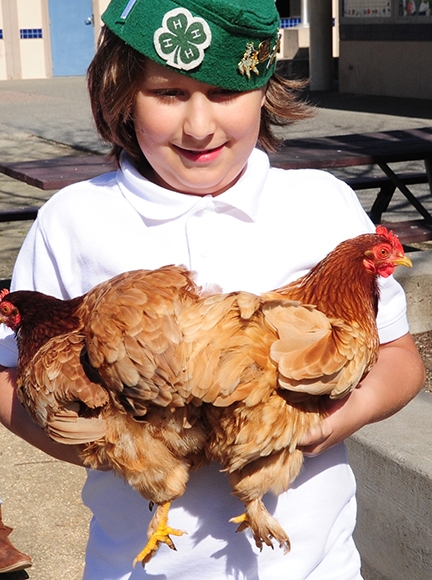
For Solano County 4-H'er Jarred Burkett, it's also FFFF (Fine Feathered Friends Forever).
Jarred, 10, a member of the Sherwood Forest 4-H Club in Vallejo raises free-range chickens at his American Canyon home — not for showing at fairs or selling at junior livestock auctions, but as pets. The self-described “Chicken Dude” is as proud, protective and possessive of his poultry as the owner of the best-of-show at the Westminster Kennel Club Dog Show.
He and Frostbite, his chocolate red cochin bantam, born April 1, 2016, are good buddies, just like the iconic TV stars Lassie and Timmy. In this case, it's not about “a boy and a dog” but “a boy and his chicken.”
At the recent Solano County 4-H Presentation Day, held at the Tremont Elementary School, Dixon, Jarred eagerly talked about Frostbite in his presentation that won a blue seal (“very good”) award. The origin of the name? “She was the whitest chick and she always pecked.”
“He loves his chickens,” says his mother, Mary Ann Burkett, a co-community leader of the Sherwood Forest 4-H Club and the Vallejo-Benicia representative to the Solano County 4-H Leaders' Council. “He climbs The Hill behind our house, where the chickens are. I'd say he spends about two hours a day, total, with them. He hangs out with them, collects the eggs (about 8 to 10 a day) and cleans the pens.”
Mom Mary Ann, dad Rick and their three children, Jessica, 16, Jordan, 12, and Jarred, live in a residential area that allows backyard chickens. The benefits, the family agrees, include not only positive learning experiences, but companionship, fresh eggs, and a bug-free environment.
There are no bugs at the Burkett property, thanks to their flock of 11 chickens.
“The 4-H Poultry Project provides youth a fun and hands-on learning experience that develops life skills; as well the opportunity to learn about caring for and raising chickens responsibly and humanely,” said Solano County 4-H Representative Valerie Williams. “Although it should not be their only source of food, chickens will snack on weeds, vegetable trimmings, as well as eat insects in your garden, making them great recyclers!”
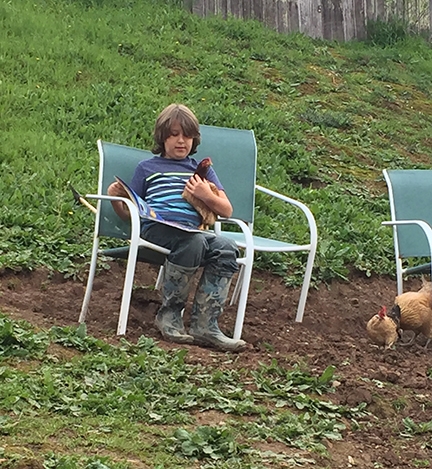
The Burketts, who home-school their youngsters, have also found a way to encourage both reading and physical education. That involves climbing The Hill and tending to the flock. Jarred pulls up a chair and reads to his chickens.
When he or his sisters feel a little sad, a hike up the hill to be with the chickens is all it takes. “Therapy,” says mom.
Frostbite clings to Jarred, and Jarred to her, especially after the bantam's near-death experience in January with a hawk. Jordan helped rescue her. Now one of their dogs alerts the flock to pending danger and the chickens run for cover.
As a 4-H'er, Jarred shows Frostbite at 4-H events; at the Solano County Fair's Youth Ag Day; and at other special events, but not for competition at county fairs. She's a pet. For Jarred, that means he won't leave his pet there alone, especially in a cage. Besides, her wings are clipped (a disqualification).
Another chicken enthusiast is Jarred's sister, Jordan, who owns Frostbite's mother, Twilight. Known as “The Chicken Whisperer,” Jordan communicated with her chicken during her gold-award talk on “Fowl Language, How Chickens Communicate” at the Solano County 4-H Presentation Day. Twilight “talked” and Jordan “deciphered.”
“Buh dup” is a general greeting that means “Hello, how are you? What's up?” Jordan says, while “Doh, doh, doh” is a call heard when the flock is roosting at night, and with broody hens saying “It's okay” to her chicks. “Bwah, bwah, bwah, bwah” is a loud deliberate noise, saying “I'm going to lay an egg.” Then when she does, it's “Bah-Gaw-Gawk, Bah-Gaw-Gawk, Bah-Gaw-Gawk,” a sound starting low and reaching a crescendo.
Poultry does have its rewards. Last year Jarred's record book was named the county winner in poultry. The third-year 4-H'er also takes three other projects: remote control projects, recordkeeping and paper quilling. When he's not involved with his chickens or studying, he's hanging out with his friends and family or playing video games, hiking and bicycling.
Jarred also takes Frostbite, cradled in his arms, when the Burketts shop at the Tractor Supply Co., American Canyon. Now their new mode of transportation is a "pet buggy," a gift from a friend. In fact, Jarred and Jordan wheeled their chickens around the playground in the mesh-covered buggy at the Solano County 4-H Presentation Day. The buggy, resembling a baby buggy (yes, passersby do a double take), not only keeps them safe, they said, but soothes them.
Mary Ann Burkett is sold on 4-H. “If it weren't for his love of chickens, Jarred would probably never do Presentation Day,” she said, adding “4-H brings youth out of their shells, or out of their comfort zone. Kids tend to be more outgoing when they enroll in 4-H.”
Seven of Solano County's 11 4-H clubs offer poultry projects: Elmira 4-H Club, Pleasants Valley 4-H Club, and Vaca Valley 4-H Club, all of Vacaville; Roving Clovers 4-H Club and Tremont 4- Club, both of Dixon; Sherwood Forest 4-H Club, Vallejo-Benicia; and the Rio Vista 4-H Club.
Tremont offers their poultry projects countywide, so youth in any Solano County 4-H may enroll, Williams said. Tremont offers poultry projects to two age groups: primary members, 5 to 8 years old, and all other members, 9 to 19 years old.
The Solano County 4-H Youth Development Program, part of the UC Cooperative Extension Program, follows the motto, “Making the Best Better.” 4-H, which stands for head, heart, health and hands, is open to youths ages 5 to 19. In age-appropriate projects, they learn skills through hands-on learning in projects ranging from arts and crafts, computers and leadership to dog care, poultry, rabbits and woodworking. They develop skills they would otherwise not attain at home or in public or private schools. For more information, contact 4-H Youth Development program representative Valerie Williams at vawilliams@ucanr.edu.
